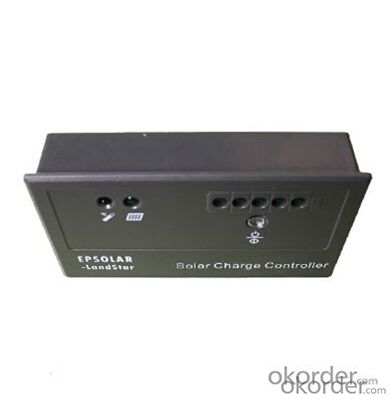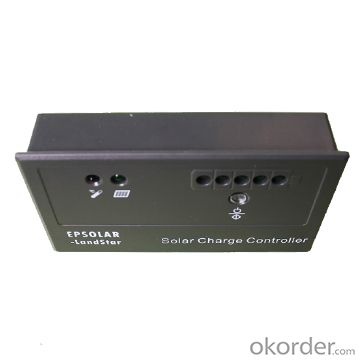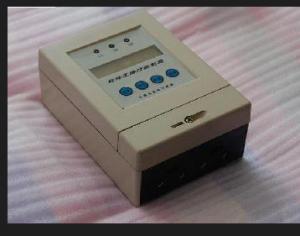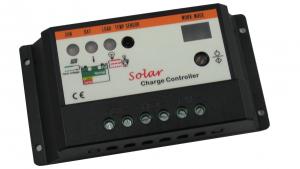Sku 1052971982 Surface Mounting PWM Solar Panel Charge Regulator/Controller, 10A, 12V/24V, LS1024S
- Loading Port:
- Tianjin
- Payment Terms:
- TT or LC
- Min Order Qty:
- -
- Supply Capability:
- 10000 pc/month
OKorder Service Pledge
OKorder Financial Service
You Might Also Like
Features:
·High efficient Series PWM charging
·Use MOSFET as electronic switch
·Gel, Sealed and Flooded battery type option
·Temperature compensation
·LED indicators indicate battery voltage state
Electronic Protections:
·over charging
·over discharging
·overload
·short circuit
·Reverse protection for battery
Specification:
Electrical parameters | LS1024S | LS2024S |
Nominal System Voltage | 12 / 24VDC auto work | |
Rated Battery Current | 10A | 20A |
Max. Battery Voltage | 32V | |
Charge Circuit Voltage Drop | ≤0.26V | |
Discharge Circuit Voltage Drop | ≤0.15V | |
Self-consumption | ≤6mA | |
Overall dimension | 120 x 68 x 40mm | 128 x 87x 48mm |
Terminal | 4mm2 | 10mm2 |
Net weight | 0.15kg | 0.25kg |
Working temperature | -35℃ to +55℃ | |
Battery Voltage Parameters (temperature at 25℃) | |||
Battery charging setting | Gel | Sealed | Flooded |
Equalize Charging Voltage | —— | 14.6V;x2/24V | 14.8V;x2/24V |
Boost Charging Voltage | 14.2V;x2/24V | 14.4V;x2/24V | 14.6V;x2/24V |
Float Charging Voltage | 13.8V;x2/24V | 13.8V;x2/24V | 13.8V;x2/24V |
Low Voltage Reconnect Voltage | 12.6V;x2/24V | 12.6V;x2/24V | 12.6V;x2/24V |
Low Voltage Disconnect Voltage | 11.1V;x2/24V | 11.1V;x2/24V | 11.1V;x2/24V |

FAQ:
Q1. What is the voltage?
A1. Our 45/60A solar charge controller is 12/24/36/48V auto work.
Q2. What is the difference between MPPT&PWM?
A2. MPPT has higher efficiency, it can track the max power point and won't waste energy.
Q3. What is the efficiency of the MPPT controller?
A3. MPPT>99%, peak conversion efficiency>98%.
Q4. What is the waranty of product?
A4. 12 months.
Q5. What protection does your MPPT controller have?
A5. PV array short circuit, PV reverse polarity, Battery reverse polarity, Over charging, Output short circuit.
- Q: How does a solar controller handle voltage drop in the wiring?
- A solar controller handles voltage drop in the wiring by utilizing a built-in circuitry that detects and compensates for the drop in voltage. It adjusts the charging parameters accordingly to ensure the solar panel's output voltage is sufficient to charge the battery effectively, despite the voltage loss in the wiring.
- Q: Do solar controllers require a separate power source?
- No, solar controllers do not require a separate power source. They are designed to work directly with the power generated by solar panels.
- Q: Can a solar controller be used with solar panels of different angles?
- Yes, a solar controller can be used with solar panels of different angles. The purpose of a solar controller is to regulate the flow of electricity from the solar panels to the battery or grid. It does not depend on the angle of the solar panels. The angle of the solar panels affects the efficiency and output of the solar system, but it does not impact the compatibility or functionality of the solar controller. Therefore, regardless of the angle of the solar panels, a solar controller can still be used to manage the charging and discharging of the battery or the flow of electricity to the grid.
- Q: How does a solar controller handle battery desulfation?
- A solar controller handles battery desulfation by periodically applying a high voltage pulse to the battery, which helps break down and remove sulfation buildup on the battery plates. This process helps to rejuvenate the battery and improve its overall performance and lifespan.
- Q: What are the signs of a faulty solar controller?
- There are several signs that can indicate a faulty solar controller. Here are a few common ones: 1. Battery Overcharging: If you notice that your batteries are constantly being overcharged, it could be a sign that your solar controller is not functioning properly. Overcharging can cause damage to the batteries and reduce their lifespan. 2. Battery Undercharging: On the other hand, if your batteries are not being fully charged or are consistently undercharged, it may indicate a faulty solar controller. This can lead to a decrease in battery capacity and overall system performance. 3. Inconsistent Power Output: If you notice that your solar panels are not consistently producing power or are not providing the expected output, it could be a sign of a faulty solar controller. The controller regulates the flow of power from the panels to the batteries, and any malfunction can disrupt this process. 4. Erratic Display or Error Messages: If the display on your solar controller is behaving erratically or showing error messages, it could indicate a problem with the controller. These error messages may include warnings about overvoltage, undervoltage, or other issues. 5. Excessive Heating: A faulty solar controller may generate excessive heat, which can be felt when touching the controller. This can be a sign of internal component failure or poor thermal management, both of which can affect the controller's performance. 6. Intermittent or Non-Functioning Load Control: If the solar controller is responsible for controlling loads connected to the system, such as lights or appliances, and you notice that these loads are not working consistently or not at all, it may be due to a faulty controller. It is important to note that these signs can also be caused by other issues in the solar system, so it is recommended to consult with a professional or contact the manufacturer for further troubleshooting and assistance.
- Q: Can a solar controller be used with a solar-powered landfill gas extraction system?
- Yes, a solar controller can be used with a solar-powered landfill gas extraction system. The solar controller helps regulate and optimize the charging and discharging of the batteries used to store the solar energy generated by the system. It ensures that the extracted landfill gas is efficiently converted into electricity while maintaining the battery life and system performance.
- Q: What is the maximum charging power of a solar controller?
- The highest rate at which a solar controller can convert solar energy into electrical power to charge a battery or power a load is referred to as its maximum charging power. The specific maximum charging power of a solar controller may vary depending on the model and specifications of the controller. This measurement is typically done in watts (W) or amps (A). Determining the maximum charging power involves considering factors such as the size and quality of the solar panel array, the efficiency of the controller's electronics, and the capacity of the battery being charged. When designing or selecting a system, it is crucial to take into account the maximum charging power of the solar controller to ensure that it can meet the power requirements of the intended application.
- Q: What is the role of a solar controller in preventing battery under-voltage?
- Maintaining the health and performance of the battery system in a solar power setup relies heavily on the crucial role played by a solar controller in preventing battery under-voltage. Also known as a charge controller, a solar controller is responsible for regulating the flow of electrical charge from the solar panels to the batteries. Acting as an intermediary between the panels and batteries, it ensures that the batteries receive the appropriate amount of charge, avoiding both overcharging and undercharging. One of the primary functions of a solar controller is to prevent battery under-voltage. This occurs when the battery's voltage drops below the recommended minimum level, which can result in permanent damage and a significant reduction in its lifespan. To tackle this issue, the solar controller constantly monitors the battery's voltage level. As soon as it detects that the voltage is approaching or falling below the minimum threshold, it takes immediate action to prevent further discharge and harm. Typically, this involves disconnecting the connection between the solar panels and the batteries, effectively blocking any additional charge from flowing into the batteries. Furthermore, advanced solar controllers may incorporate features like low voltage disconnect (LVD) or battery protection algorithms. These features automatically disconnect the load from the battery when the voltage reaches a critical level, safeguarding the battery from further discharge and potential damage. By efficiently averting battery under-voltage, a solar controller ensures that the battery remains in a healthy state, maximizing its lifespan and overall performance. This is especially crucial in off-grid or remote solar power systems where the batteries serve as the primary energy storage source.
- Q: What is the role of a solar controller in preventing damage to the solar panels from power surges?
- The prevention of damage to solar panels from power surges is of utmost importance, and this is where the solar controller comes into play. Referred to as a charge controller as well, it acts as an intermediary between the solar panels and the battery or power grid. Its main objective is to ensure that the energy produced by the panels is stored or used efficiently and securely. One crucial function of the solar controller is safeguarding the solar panels from power surges. These surges occur when there is a sudden surge in voltage, which may be caused by lightning strikes, fluctuations in the power grid, or other external factors. These unforeseen events can have detrimental effects on the delicate electronic components of the solar panels, greatly reducing their lifespan or rendering them completely useless. To prevent damage from power surges, the solar controller effectively manages the flow of electricity from the panels to the battery or grid. It expertly regulates the voltage and current levels, ensuring they remain within safe parameters. When a power surge is detected, the controller acts as a protective barrier, effectively blocking the surge from reaching the vulnerable solar panels. Moreover, many solar controllers are equipped with built-in surge protection devices, including surge arresters or metal oxide varistors (MOVs). These devices are designed to absorb excessive voltage spikes and redirect them away from the panels, providing an extra layer of protection against potential damage. In summary, the role of the solar controller in preventing damage to solar panels from power surges is to maintain control over the flow of electricity and shield the panels from sudden increases in voltage. By acting as a protective barrier and incorporating surge protection devices, the controller ensures the long-lasting performance and optimal functionality of the solar panels, ultimately maximizing the efficiency and effectiveness of the entire solar power system.
- Q: How do I connect a solar controller to a solar-powered water heater?
- To connect a solar controller to a solar-powered water heater, you will need to follow a few steps: 1. Identify the solar controller: The solar controller is a device that regulates the flow of energy from the solar panels to the water heater. It is typically located near the solar panels and will have various input and output terminals. 2. Determine the type of solar controller: There are different types of solar controllers available, such as PWM (Pulse Width Modulation) and MPPT (Maximum Power Point Tracking). Make sure you have the appropriate controller for your system. 3. Locate the water heater: Identify the water heater's input and output terminals. These terminals are usually marked as "inlet" and "outlet" on the heater. 4. Connect the solar panels: Connect the solar panels to the input terminals of the solar controller. Follow the manufacturer's instructions for proper wiring and ensure that the positive and negative terminals are correctly connected. 5. Connect the water heater: Connect the outlet terminals of the solar controller to the inlet terminals of the water heater. Again, refer to the manufacturer's instructions for proper wiring. 6. Configure the solar controller: Once the connections are made, you may need to configure the solar controller based on your specific system requirements. This may involve setting temperature limits, flow rates, or other parameters. 7. Test the system: After completing the connections and configuration, test the system to ensure it is functioning correctly. Monitor the water temperature and flow to verify that the solar controller is effectively heating the water. Remember, it is crucial to consult the user manual or seek professional assistance if you are unsure about any step or have any concerns. Safety precautions should always be followed when working with electrical components.
Send your message to us
Sku 1052971982 Surface Mounting PWM Solar Panel Charge Regulator/Controller, 10A, 12V/24V, LS1024S
- Loading Port:
- Tianjin
- Payment Terms:
- TT or LC
- Min Order Qty:
- -
- Supply Capability:
- 10000 pc/month
OKorder Service Pledge
OKorder Financial Service
Similar products
Hot products
Hot Searches
Related keywords






























